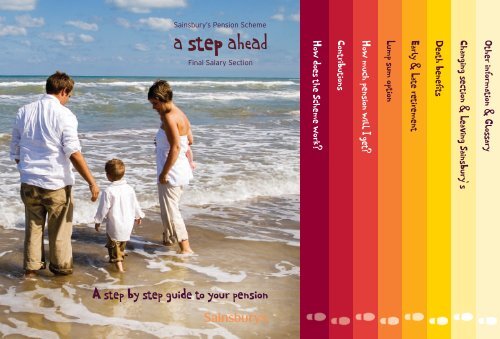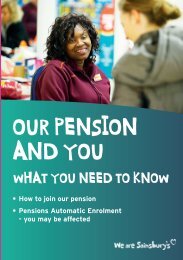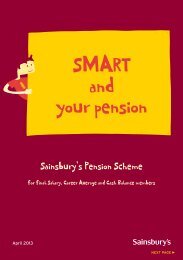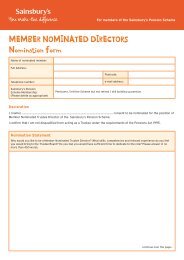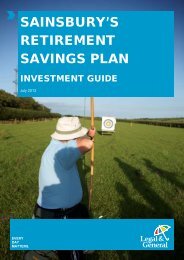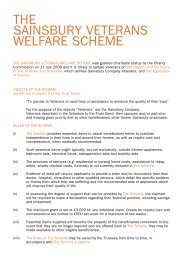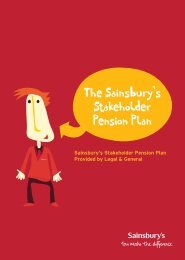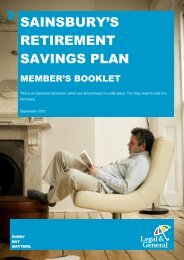Final Salary Section - Sainsbury's pensions website
Final Salary Section - Sainsbury's pensions website
Final Salary Section - Sainsbury's pensions website
You also want an ePaper? Increase the reach of your titles
YUMPU automatically turns print PDFs into web optimized ePapers that Google loves.
Sainsbury’s Pension Scheme<br />
<strong>Final</strong> <strong>Salary</strong> <strong>Section</strong><br />
How does the Scheme work?<br />
Contributions<br />
How much pension will I get?<br />
Lump sum option<br />
Early & Late retirement<br />
Death benefits<br />
Changing section & Leaving Sainsbury’ s<br />
Other information & Glossary<br />
A step by step guide to your pension
How does the Scheme work?<br />
Your Sainsbury’s pension is a valuable<br />
benefit. It provides a pension linked to your<br />
final earnings, serious ill-health protection<br />
and benefits for your Dependants in the<br />
event of your death.<br />
The Scheme is set up under Trust and run by a Trustee<br />
company which is a separate legal entity from Sainsbury’s.<br />
The Trustee company has a legal duty to safeguard your<br />
interests. Some of its directors are chosen by Sainsbury’s<br />
and some are selected by Scheme members. You can find<br />
details of the Trustee board on www.js<strong>pensions</strong>.com.<br />
How does the Scheme work?<br />
A number of changes have taken place so please take the<br />
time to read this guide.<br />
An explanation of special terms can be found at the back<br />
of this guide and appear as bold in the text.<br />
Please Note:<br />
This guide is a summary of the Scheme’s<br />
Trust Deed & Rules. It is intended only as a<br />
guide for Active members. Your benefits will<br />
always be calculated using the Trust Deed &<br />
Rules and general <strong>pensions</strong> law. If there is<br />
any difference between this guide and the<br />
Trust Deed & Rules, the Trust Deed & Rules<br />
will prevail.<br />
You should consider taking independent financial<br />
advice before making any decision which could affect<br />
your pension.<br />
2
Membership<br />
Membership of the Sainsbury’s Pension Scheme, <strong>Final</strong><br />
<strong>Salary</strong> section, is now closed. This means that no one<br />
else can become a member and, if you choose to opt out<br />
of membership, you cannot rejoin.<br />
See page 16 for more information on changing sections.<br />
It is not possible to transfer in pension benefits to the<br />
Scheme.<br />
Contributions<br />
3
Contributions<br />
Your contribution rate is 10% of your Pensionable earnings.<br />
The true cost to you is less than this amount because you get tax<br />
relief on your contributions at the highest rate you pay. You also pay<br />
lower National Insurance contributions as the Scheme is Contracted<br />
out of the State Second Pension.<br />
The balance of the cost of providing your benefits is met by<br />
Sainsbury’s.<br />
Contributions<br />
SMART<br />
SMART is a <strong>Salary</strong> sacrifice arrangement where Sainsbury’s pays<br />
your contributions for you. If you are in SMART, Sainsbury’s pays an<br />
amount equal to your normal pension contribution and reduces your<br />
salary by the same amount. SMART is designed so that you and<br />
Sainsbury’s pay less National Insurance. Your take-home pay<br />
increases by the amount you save. You must earn above the pay<br />
protection limit (this varies every year) to benefit from SMART. See<br />
www.js<strong>pensions</strong>.com for a copy of the SMART guide relevant to this<br />
Scheme. SMART does not reduce the amount of salary used for<br />
calculating Pensionable earnings.<br />
Capping of contributions and benefits<br />
Members who joined the Scheme after 1 June 1989 are subject to a<br />
cap on their Pensionable earnings used for calculating benefits and<br />
contributions. This will be increased each year broadly in line with the<br />
increase in price inflation.<br />
A ‘Lifetime Allowance’ also operates on tax-approved pension saving.<br />
For tax years 2010/11 to 2011/12 the maximum Capital value of your<br />
total pension (from all schemes) is £1.8m. This will reduce to £1.5m<br />
from April 2012. This amount will be changed from time to time.<br />
4
Normal pension age<br />
You can take your pension at any age<br />
between 55 and 75.<br />
Benefits will be reduced for early payment if<br />
taken before age 65, which is your Normal<br />
pension age.<br />
For women, any Pensionable service up to<br />
26 September 1992 has a protected<br />
retirement age of 60. For men this protection<br />
runs from 17 May 1990 to 26 September 1992.<br />
Your Normal pension age for the payment of<br />
these benefits is still 65, but we take this<br />
protected service into account when<br />
calculating your final pension benefit.<br />
How much pension will I get?<br />
5
How much pension will I get?<br />
Your pension can be calculated in one of two ways, and the method which<br />
gives the greater amount of pension is used.<br />
The first method is using an accrual rate:<br />
Pensionable service 1<br />
Accrual rate 2 x <strong>Final</strong> pensionable earnings 3<br />
1. Complete years’ and months’ membership of the <strong>Final</strong> <strong>Salary</strong> section.<br />
2. Your Accrual rate is 60ths. This is the rate at which your pension<br />
builds up.<br />
3. <strong>Final</strong> pensionable earnings are:<br />
> Your best annual Pensionable earnings (excluding overtime) in any one<br />
of the five full financial years immediately before the end of your<br />
Pensionable service; plus the annual average of overtime over the<br />
three years before the end of your Pensionable service.<br />
How much pension will I get?<br />
For example:<br />
Jo has 20 years’ service in the <strong>Final</strong> <strong>Salary</strong> section and retires at 65<br />
(Normal pension age) on <strong>Final</strong> pensionable earnings of £12,000.<br />
The pension at retirement from the <strong>Final</strong> <strong>Salary</strong> section would be:<br />
20 x £12,000 = £4,000 per year<br />
60<br />
6
The alternative method is an amount which relates to your member<br />
contributions. How much you get depends on when you joined the<br />
Scheme and is different for different periods of service. The rates<br />
and the periods of service to which they relate are as follows:<br />
For service completed:<br />
£1.00 of pension for<br />
every member<br />
contribution of:<br />
On or before 27 March 2004 £2.55<br />
28 March 2004 to 9 September 2006 £4.20<br />
On and after 10 September 2006 £6.00<br />
How much pension will I get?<br />
Buying back pension – pre-1978 joiners<br />
If you joined the Scheme before 1978, when you retire, you can buy<br />
back up to 18 months of Pensionable service to take account of<br />
the waiting period to join the Scheme that existed at that time.<br />
How <strong>pensions</strong> are paid<br />
Your pension will be paid four-weekly in advance into an account in<br />
your name.<br />
What if I get divorced?<br />
If you divorce your Spouse or dissolve a Civil partnership, the<br />
court may order part of your pension benefit to be transferred to<br />
your former Spouse. If this is the case, you can continue to be a<br />
member but your benefits will be reduced.<br />
7
What if I work part time?<br />
If you have a period of part-time service, your Pensionable service will<br />
be a proportion of your full-time equivalent service. On leaving<br />
Pensionable service or retirement, full-time equivalent earnings will be<br />
used to calculate your pension rather than actual earnings. For example:<br />
A member works full time for five years and has a salary of £10,000 per<br />
year. Their pension is:<br />
5 x £10,000 = £833 per year<br />
60<br />
Another member works part time (half hours) for five years and has a<br />
full-time equivalent salary of £10,000 per year, but only earns £5,000<br />
per year due to working part time. Their pension is:<br />
How much pension will I get?<br />
2.5 x £10,000 = £417 per year<br />
60<br />
0.5/0 x £10,000 = £83 per year<br />
(Pensionable earnings are worked out using the full-time equivalent,<br />
hence £10,000).<br />
8
Lump sum option<br />
You can normally exchange part of your pension<br />
for a cash lump sum, which is currently tax free.<br />
The amount of pension which can be taken as a<br />
lump sum is limited by law. For most members the<br />
maximum amount is 25% of the Capital value of<br />
the pension.<br />
Before taking any lump sum payment, you may ask<br />
the Trustee to reduce your pension in order to<br />
provide a pension for one or more of your<br />
Dependants in the event of your death. For<br />
example, you may wish to take a smaller pension<br />
with a larger pension being due to your Spouse on<br />
your death. You must request this option at least<br />
four weeks before your pension is due to start. The<br />
Sainsbury’s Pension Team can provide further<br />
details.<br />
Lump sum option<br />
9
Early retirement<br />
You may request payment of your pension at any time after age<br />
55. This early pension will be reduced for each year it is paid<br />
before your Normal pension age of 65.<br />
If you are thinking of retiring early and would like provisional<br />
figures to consider, please contact the Sainsbury’s Pension Team<br />
Subject to Sainsbury’s consent and you giving six months’ notice, if<br />
you have completed 40 years’ Pensionable service (across all<br />
sections of the Scheme) you may be able to take your pension with<br />
no reduction for early payment.<br />
Early & Late retirement<br />
For example:<br />
John retires at age 60 after 10 years’ Pensionable service<br />
with <strong>Final</strong> pensionable earnings of £12,000.<br />
At the time he retires the reduction at age 60 is 27%, so he<br />
receives 73%* of these benefits.<br />
His pension is worked out as follows:<br />
10 x £12,000 x 73% = £1,460 per year<br />
60 (the Accrual rate)<br />
*This rate is for illustration only and may be different at the<br />
time you retire.<br />
10
Early retirement on ill-health grounds<br />
You can apply for early payment of your pension on serious ill-health grounds.<br />
Active members must apply for the consent of both Sainsbury’s and the<br />
Trustee board whilst in service or within six months of leaving. After six<br />
months of leaving you will be able to apply as a Deferred member, see<br />
page 17 ‘What if I leave Sainsbury’s?’.<br />
As well as requiring consent, you must meet the Scheme’s ill-health conditions.<br />
You must be too ill to work for any employer ever again. Medical evidence will<br />
be required to support your application and ongoing eligibility. Your pension<br />
may be reduced or suspended if your health improves to the extent that in the<br />
Trustee’s opinion you are able to work again.<br />
Early & Late retirement<br />
If you are granted an ill-health pension it will be based on:<br />
> your Pensionable service to date; plus<br />
> half your potential service to age 65 (subject to a maximum of 40 years); and<br />
> your <strong>Final</strong> pensionable earnings at the date of leaving Pensionable service.<br />
There will be no reduction for early payment.<br />
If you are terminally ill you may be able to take all of your pension benefit<br />
as a lump sum.<br />
Late retirement<br />
If you are in Pensionable service after age 65, you can:<br />
> Carry on building your Personal Retirement account up to age 75; or<br />
> Stop paying into the pension scheme at any time and use your Personal<br />
Retirement account to buy pension when you finally retire; or<br />
> Stop paying into the pension scheme and take your pension while you carry on<br />
working .<br />
11
12<br />
Death benefits
Death benefits<br />
Death in service<br />
The following benefits are payable if you die whilst an Active<br />
member:<br />
Lump sum<br />
A lump sum is payable equal to the sum of:<br />
> four times your <strong>Final</strong> pensionable earnings;<br />
> your contributions (if no Spouse’s/Dependant's pension is<br />
payable); and<br />
> the value of your Additional Voluntary Contributions (AVCs).<br />
The Trustee has discretion over who it pays the lump sum to. Your<br />
wishes will be considered if notified using a nomination of<br />
beneficiary form. This form is available from www.js<strong>pensions</strong>.com,<br />
your annual pension statement or the Sainsbury’s Pension Team.<br />
Spouse's pension<br />
A pension will be payable to your Spouse. The amount of pension<br />
will be equal to half of your pension calculated on Pensionable<br />
service to the date of your death plus half potential service to age<br />
65. It will also be based on <strong>Final</strong> pensionable earnings at the date<br />
of death.<br />
Children's allowances<br />
Children’s allowances are payable for up to two dependent children<br />
under 16 or between ages 16 and 21 if they are in full-time<br />
education. A child’s pension may be paid for longer if they have a<br />
disability.<br />
The amount payable depends on whether a pension is payable to<br />
your Spouse or Dependant.<br />
If a pension is payable to a Spouse or Dependant, each eligible<br />
child will receive a pension equal to the greater of £780 per year<br />
or 10% of the Spouse’s/Dependant’s pension.<br />
If no Spouse’s or Dependant's pension is payable (or stops being<br />
paid), each eligible child will receive a pension equal to the greater<br />
of £780 per year or 50% of the Spouse’s/Dependant's pension.<br />
If you have more than two eligible children the total amount of<br />
benefit can be shared amongst all your children or the Trustee<br />
may pay an additional benefit to the other children.<br />
Eligible children are natural, adopted and dependent step children.<br />
Death benefits<br />
If there is no Spouse a pension may instead be payable at the<br />
Trustee’s discretion to one or more of your Dependants.<br />
13
Death in retirement<br />
The following benefits are payable if you die after your pension has become payable:<br />
Lump sum<br />
If you die within five years of retirement, a lump sum payment of the balance of the pension for<br />
the five-year period is paid. In certain cases the current tax regime may restrict this payment. If<br />
this is the case the Trustee will aim to pay an alternative benefit of equal value e.g. an increased<br />
Spouse’s pension.<br />
Death benefits<br />
The Trustee has discretion over who it pays the lump sum to. Your wishes will be considered if<br />
notified using a nomination of beneficiary form. This form is available from www.js<strong>pensions</strong>.com,<br />
your annual pension statement or the Sainsbury’s Pension Team.<br />
Spouse's pension<br />
A pension to your Spouse (providing you were married or in a registered Civil partnership before<br />
retirement or Normal pension age if earlier) of 50% of your pension.<br />
If you were not married or in a registered Civil partnership before retirement or Normal pension<br />
age if earlier then, if you die within six months of getting married or entering into your Civil<br />
partnership a Guaranteed Minimum Pension is payable. If you die after six months of getting<br />
married or entering into a Civil partnership the pension payable to your Spouse will be 50% of<br />
your pension. Under these circumstances, if your Spouse is under age 60 when you die the<br />
pension will stop being paid if they re-marry.<br />
The pension payable to your Spouse is based on your pension after any lump sum has been taken.<br />
If there is no Spouse, a pension may be payable instead at the Trustee’s discretion to one or more<br />
of your Dependants.<br />
Children's allowances<br />
Children’s allowances will be payable in the same manner as allowances payable on<br />
death in service.<br />
14
15<br />
Changing section & Leaving Sainsbury’ s
Can I change section?<br />
Yes, you can move into the Career Average or Cash Balance section of the Scheme<br />
at any time. These sections have a lower member contribution rate.<br />
The Career Average section calculates your pension in a different way from the<br />
<strong>Final</strong> <strong>Salary</strong> section but most of the associated benefits are broadly similar.<br />
The Cash Balance section is different and you should read the Cash Balance guide<br />
carefully before making a decision. You should also consider taking independent<br />
financial advice.<br />
Once you have opted out of the <strong>Final</strong> <strong>Salary</strong> section you cannot move back into<br />
it at any time.<br />
If you do change section then your <strong>Final</strong> <strong>Salary</strong> benefits will be on the basis of your<br />
Pensionable service up to the time that you change and your <strong>Final</strong> pensionable<br />
earnings at that time but increased in line with the Retail Prices Index (inflation)<br />
whilst you are an Active member.<br />
Members who were promoted to grade C6/6S or above on or before 24 February<br />
2006 will automatically be transferred to the Executive section on completion of five<br />
years’ active membership of a Sainsbury’s Pension Scheme at that grade. Members<br />
who were promoted after this date will remain in this Scheme and benefits will not<br />
transfer to the Executive Scheme.<br />
If you wish to leave the Scheme but are not leaving Sainsbury’s you can do so at any<br />
time by completing an opt-out form available from www.js<strong>pensions</strong>.com or the<br />
Sainsbury’s Pensions Team, providing a minimum of four weeks’ notice. You cannot<br />
rejoin the Scheme at a later date. You may instead join the J Sainsbury<br />
Stakeholder Plan.<br />
You should take independent financial advice before making any decision which<br />
could affect your pension.<br />
Changing section & Leaving Sainsbury’ s<br />
16
What if I leave Sainsbury’s?<br />
The following benefits are payable:<br />
Deferred pension<br />
This will be payable from age 65 but based on the pension you had built up at the date of leaving Pensionable service plus any<br />
increases. Your pension in excess of the Guaranteed Minimum Pension element will be increased each year until your pension comes<br />
into payment as follows:<br />
> Pension accrued to 5 April 2009: increased by the Retail Prices Index (inflation) up to a maximum of 5% per year.<br />
> Pension accrued from 6 April 2009: increased by the Retail Prices Index (inflation) up to a maximum of 2.5% per year.<br />
Early payment<br />
You can apply to the Trustee for early payment of your pension if you are over the age of 55. Your pension will be reduced for early<br />
payment before age 65.<br />
Ill-health<br />
If you suffer serious ill-health you can apply to the Trustee and Sainsbury’s for agreement to pay an early pension on ill-health grounds.<br />
If you joined the Scheme before 28 March 2004 your pension will not be reduced for early payment for benefits earned up to that date,<br />
but benefits earned on or after that date will be reduced for early payment.<br />
If you joined the Scheme on or after 28 March 2004 your pension will be reduced for early payment. If you recover this payment may<br />
be reduced or withdrawn. You may be required to provide medical evidence of your ongoing eligibility.<br />
If you are terminally ill you may be able to take all of your pension benefit as a lump sum.<br />
Transfer your pension<br />
You can transfer the value of your benefits out of the Scheme to your new employer’s scheme, a personal pension or stakeholder plan<br />
or an appropriate buy-out contract (if HM Revenue & Customs approved). Independent financial advice should be taken before<br />
deciding on this course of action.<br />
Changing section & Leaving Sainsbury’ s<br />
17
Late payment<br />
You may ask the Trustee to agree to postpone payment of your pension until no<br />
later than age 75. You must notify the Trustee of this request at least three months<br />
before your Normal pension age. Your pension will be increased for late payment.<br />
Lump sum option<br />
You may give up part of your pension in exchange for a cash lump sum, currently<br />
tax free.<br />
Death benefits<br />
If you die after leaving Pensionable service with an entitlement to a deferred<br />
pension, the following benefits are payable:<br />
> A pension to your Spouse of 50% of your deferred pension. If there is no Spouse,<br />
a pension may be payable instead at the Trustee’s discretion to one or more of<br />
your Dependants.<br />
> Where no Spouse's or Dependant's pension is paid a lump sum is payable at the<br />
Trustee’s discretion equal to your own contributions with interest added, currently<br />
at 3% per year from the date of leaving. This rate could change.<br />
> The value of your Additional Voluntary Contributions (if applicable).<br />
Changing section & Leaving Sainsbury’ s<br />
18
Increases to <strong>pensions</strong> in payment<br />
Part of your pension due from being Contracted out of<br />
the State Second Pension (the Guaranteed Minimum<br />
Pension) is increased by an amount set by law. You will<br />
be notified about this on retirement.<br />
The rest is increased every year by the increase in the<br />
Retail Prices Index and is capped as follows:<br />
> Benefits earned up to 5 April 1997 – 3%.<br />
> Benefits earned from 6 April 1997 to 5 April 2006 – 5%.<br />
> Benefits earned from 6 April 2006 onwards – 2.5%.<br />
The Trustee and Sainsbury’s have discretion to award<br />
additional increases.<br />
Maternity leave<br />
You will continue to build up Pensionable service and<br />
benefit from life cover for up to 12 months. You will<br />
continue to make contributions from any contractual and<br />
statutory pay you receive. This means that you continue<br />
to build up full pension whilst on leave.<br />
Other information & Glossary<br />
Approved career break<br />
You continue to benefit from life cover for up to 12<br />
months. This period will not count as Pensionable<br />
service. However, if you return to work at the end of this<br />
break, we will link your pre and post break Pensionable<br />
service and allow you to continue being an Active<br />
member. If you do not return to work you will become a<br />
Deferred member.<br />
19
Temporary absence continued<br />
Time away from work for other reasons<br />
Your benefits may be affected if you are absent from work for 12 months or more. If you are likely to be absent<br />
from work for a prolonged period, you can contact the Sainsbury’s Pension Team for more information about<br />
your contributions and benefits during this time.<br />
Saving more for your retirement<br />
Additional Voluntary Contributions (AVCs)<br />
The AVC option has now closed and you can no longer pay AVCs to the Scheme. Money invested within AVC<br />
accounts before 10 September 2006 can be used to purchase additional pension at retirement. Pension can be<br />
purchased either within the Scheme (with Trustee agreement) or from an external insurer. There are two rates<br />
available: one that will buy a pension that does not increase over time (a level pension), or another that<br />
increases broadly in line with price inflation capped at 2.5% per year (an increasing pension). You may transfer<br />
the value of your AVC account to another approved pension scheme. Independent financial advice should be<br />
taken before deciding on this course of action.<br />
Other information & Glossary<br />
You can take up to 25% of the value of your AVC fund as a cash sum, currently tax free. If you opened your<br />
existing AVC account before 8 April 1987 you may be able to take more than 25% of your AVC fund as a cash<br />
sum. The Sainsbury’s Pension Team will provide you with more information about this option at retirement.<br />
Pension top up<br />
If you want to build up additional retirement benefits, one way you could do this is to make additional<br />
contributions through Legal & General, our Stakeholder Pension provider. This means at retirement, you will<br />
buy pension at external market rates and your pension will be paid by the provider you choose and not the<br />
Scheme. You can contact the Legal & General help line on 0845 302 0323 for an application pack to join the<br />
J Sainsbury Stakeholder Pension Plan for Defined Benefit Members. Please be aware that there are other ways<br />
to save towards your retirement. An independent financial adviser will be able to outline other ways of<br />
saving appropriate to your personal circumstances and it is recommended that you take independent<br />
financial advice before making any decision which could affect your pension.<br />
20
Other information<br />
National Insurance rebate<br />
As a member of the Scheme, you will be Contracted out of the<br />
State Second Pension on a reference scheme basis. There is a<br />
minimum pension you will receive instead of the State Second<br />
Pension for the time you are an Active member of the Scheme,<br />
called the Guaranteed Minimum Pension. Because the Scheme is<br />
Contracted out of the State Second Pension, you pay reduced rate<br />
National Insurance contributions whilst an Active member.<br />
The Pensions Regulator<br />
The Pensions Regulator is responsible for ensuring pension<br />
schemes are run properly. It may intervene in the running of this<br />
Scheme if the Trustee, Sainsbury’s or professional advisers have<br />
failed in their duties. Its address is: Napier House, Trafalgar Place,<br />
Brighton, BN1 4DW. It also has a <strong>website</strong> containing further<br />
information about its role and responsibilities<br />
www.the<strong>pensions</strong>regulator.gov.uk.<br />
Data protection<br />
The Trustee is registered under the Data Protection Act 1998 and<br />
uses personal information about you for the purposes of<br />
administering the Scheme and paying benefits. This may include<br />
passing information about you to third parties to operate the<br />
Scheme, or for the purpose of preventing fraud. A statement<br />
detailing the Scheme’s policy on the use of personal data can be<br />
found at www.js<strong>pensions</strong>.com.<br />
Assignment<br />
Your pension is personal to you and is not assignable i.e. it cannot<br />
be transferred to anyone else and you may not for example, use<br />
your benefit as security for a loan.<br />
Scheme Documents<br />
Your can request a copy of the Scheme’s Trust Deed & Rules and/or<br />
the latest report and accounts from the Sainsbury’s Pension Team.<br />
You can contact them by email at <strong>pensions</strong>@sainsburys.co.uk or<br />
write to them at 33 Holborn, London, EC1N 2HT.<br />
Member Queries<br />
If you have a question about your benefit entitlement, or about the<br />
Scheme generally, you should contact the Sainsbury’s Pension<br />
Team at the address on the back page.<br />
Support if you have a complaint<br />
Your pension is important but occasionally things can go wrong.<br />
We will always deal with your complaint fairly and as quickly as<br />
possible.<br />
If you have a query or complaint you should first write to the<br />
address on the back of this guide. If this matter cannot be resolved<br />
informally then you should ask for a dispute form.<br />
The Pensions Advisory Service (TPAS) and the Pensions<br />
Ombudsman exist to help you resolve disputes at any time during<br />
this process. They are unlikely to take up your complaint until you<br />
have received the Trustee’s decision. TPAS can also help you with<br />
general <strong>pensions</strong> queries. You can contact them at 11 Belgrave Rd,<br />
London, SW1V 1RB. The Pensions Advisory Service <strong>website</strong> is:<br />
www.<strong>pensions</strong>advisoryservice.org.uk.<br />
Debts owed to Sainsbury’s or the Scheme<br />
If you owe any money to Sainsbury’s or the Scheme because<br />
you have acted criminally, negligently or fraudulently, your<br />
benefits can be reduced to recover that debt.<br />
If your benefits are to be reduced for this reason, you will be<br />
told about it before it happens. If you dispute the amount of<br />
the debt, your benefits will not be reduced until the dispute<br />
has been resolved<br />
Other information & Glossary<br />
21
Glossary of terms<br />
The following special terms are used in this guide.<br />
Accrual rate This is the rate at which your pension builds up.<br />
You will get a certain amount for each year of Pensionable<br />
service.<br />
Active member Someone who is building up pension from<br />
their present job with Sainsbury’s.<br />
Capital value This is the overall value of your benefits from all<br />
pension schemes (including those of former employers).<br />
Civil partnership Legal recognition of relationships between<br />
couples that are gay or lesbian, which entitles them to receive<br />
similar treatment and benefits as married couples.<br />
Contracted out A Scheme where members are not in the<br />
State Second Pension.<br />
Deferred member A member who has left the Scheme but will<br />
get benefits when they retire.<br />
Dependant Your Spouse, child or another person who is<br />
financially dependent or interdependent on you.<br />
<strong>Final</strong> pensionable earnings The Pensionable earnings used<br />
to work out your final pension. See page 6 for details.<br />
Guaranteed Minimum Pension This is the minimum pension<br />
from contracting out of the State Second Pension arising from<br />
service to April 1997.<br />
Normal pension age Also known as normal retirement date.<br />
This is age 65.<br />
Pensionable earnings These are the earnings used to work<br />
out your pension benefits and contributions. They are your<br />
gross basic earnings and include overtime and shift premia<br />
but exclude bonuses and any other allowances or one-off<br />
payments.<br />
Pensionable service This is the period which is taken into<br />
account when working out your pension benefits.<br />
<strong>Salary</strong> sacrifice This is an agreement between you and<br />
Sainsbury’s. You agree to give up an amount of salary and<br />
Sainsbury’s pays the same amount as a contribution to the<br />
Scheme.<br />
Spouse Someone to whom you are legally married or have<br />
entered into a Civil partnership with.<br />
Transfer value This is the amount the Scheme will pay if you<br />
leave the Scheme and transfer the value of your benefits to<br />
another Scheme. It will be a cash equivalent amount of your<br />
benefit that you are entitled to under Chapter IV of the<br />
Pension Schemes Act 1993 or such other amount as the<br />
Trustee and Sainsbury’s may determine after taking advice<br />
from the Scheme’s actuary, subject to any limits set out in the<br />
Scheme rules.<br />
Other information & Glossary<br />
22
This guide is only a summary of the Scheme's Trust Deed & Rules. If there is any<br />
difference between this guide and the Trust Deed & Rules, the Trust Deed & Rules<br />
will prevail. The benefits of the Scheme may be changed in the future.<br />
For further information contact:<br />
Sainsbury’s Pension Team<br />
Towers Watson<br />
PO Box 545<br />
Redhill<br />
Surrey<br />
RH1 1YH<br />
Telephone: 0800 916 8087<br />
Email: sainsburys<strong>pensions</strong>@towerswatson.com<br />
October 2010<br />
Designed and produced by Anthony Hodges Consulting Limited


